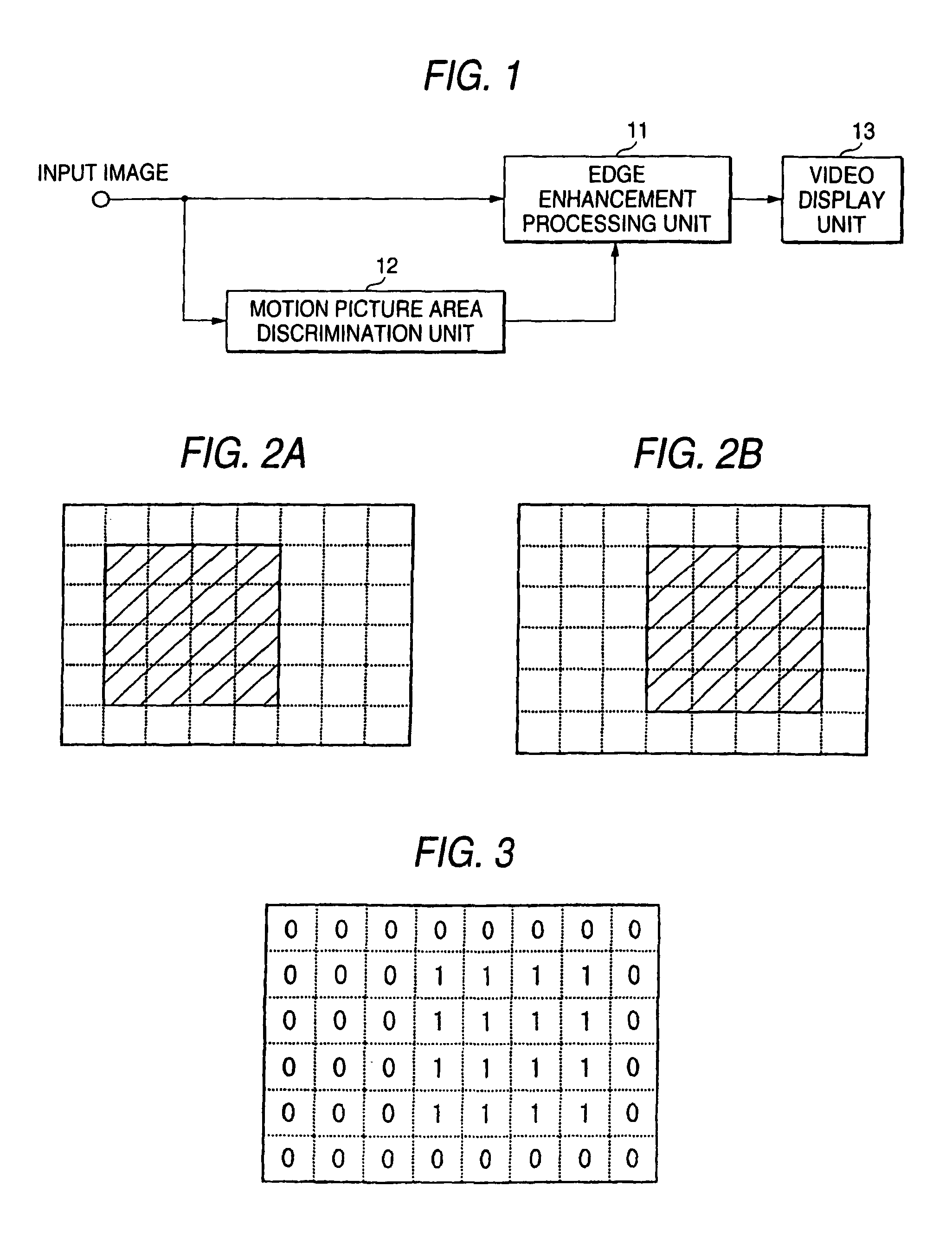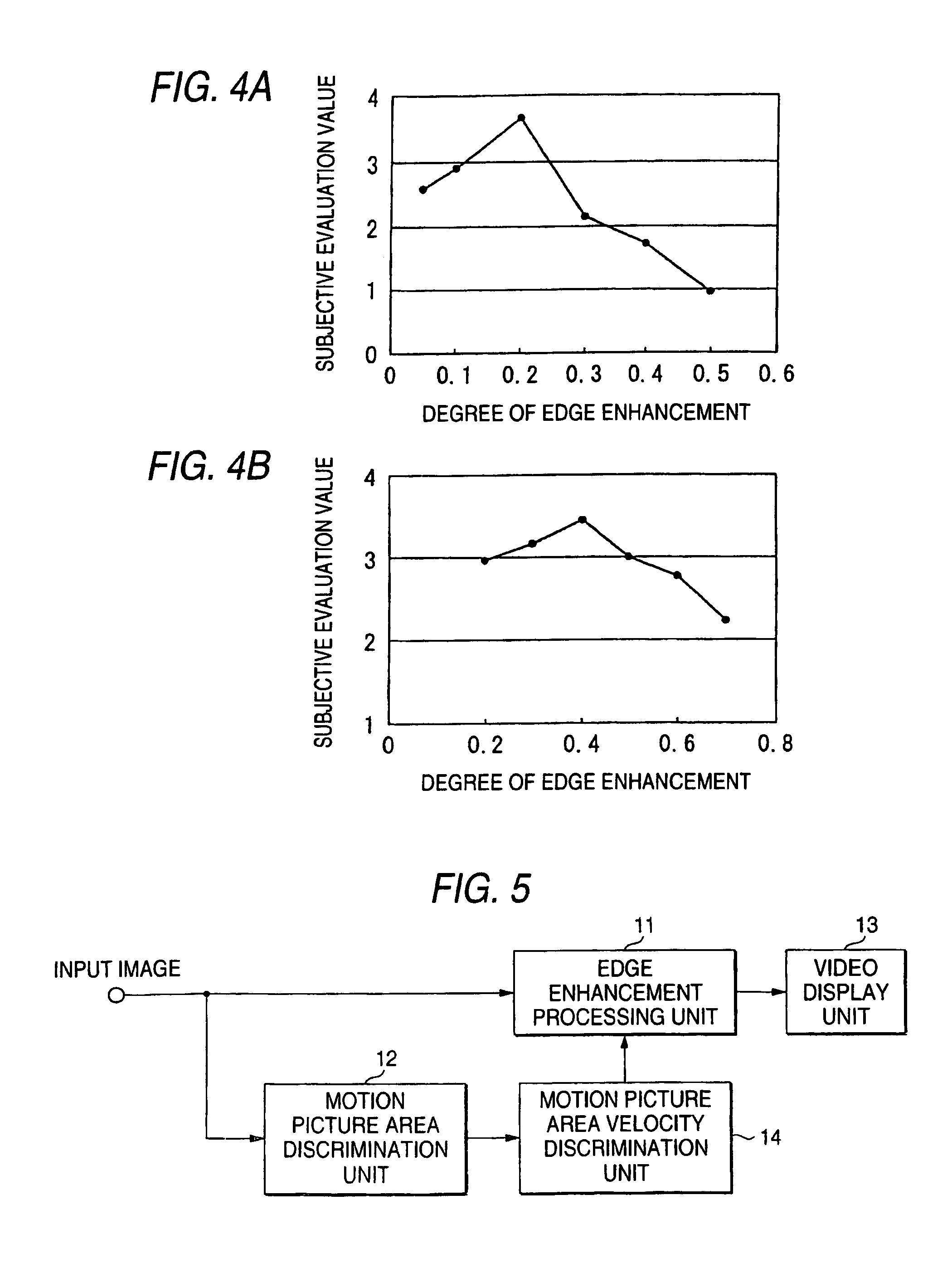Image processing method and apparatus
a processing method and image technology, applied in the field of image processing methods and apparatuses, can solve the problems of blurring, sudden loss of distinction, image blurring about moving objects, etc., and achieve the effect of enhancing edges
- Summary
- Abstract
- Description
- Claims
- Application Information
AI Technical Summary
Benefits of technology
Problems solved by technology
Method used
Image
Examples
first embodiment
(First Embodiment)
[0031]FIG. 1 shows a block diagram according to the first embodiment.
[0032]An input image is supplied to an edge enhancement processing unit 11 and a motion picture area discrimination unit 12.
[0033]The motion picture area discrimination unit 12 discriminates between motion picture areas and still picture areas, and supplies position information of the motion picture areas to the edge enhancement processing unit 11 as motion picture area information.
[0034]In the edge enhancement processing unit 11, edge enhancement processing is performed with different degrees of edge enhancement between the still picture areas and the motion picture areas of the input image on the basis of the motion picture area information.
[0035]After that, the image subjected to the edge enhancement processing is supplied to a video display unit 13 so as to be presented to an observer.
[0036]Next, the operation of each unit will be described.
[0037]The motion picture area discrimination unit 12 ...
second embodiment
(Second Embodiment)
[0058]FIG. 5 shows a block diagram of the second embodiment related to a video display method according to the invention. Incidentally, in FIG. 5, constituent units the same as those in FIG. 1 are denoted by the same reference numerals correspondingly, and duplicated description will be omitted.
[0059]The fundamental configuration is similar to that of the first embodiment, except that a motion picture area velocity discrimination unit 14 for discriminating a motion velocity for each moving object divided by the motion picture area discrimination unit 12 is added in this embodiment.
[0060]The positions and velocities of the motion picture areas obtained by the motion picture area velocity discrimination unit 14 are supplied to the edge enhancement processing unit 11 as motion picture area velocity information.
[0061]In the edge enhancement processing unit 11, edge enhancement processing in accordance with the motion velocities in the still picture areas and the motio...
third embodiment
(Third Embodiment)
[0074]Also in this embodiment, the fundamental configuration is similar to that of the first embodiment. However, this embodiment is characterized in that the degree of edge enhancement for each pixel is determined in accordance with the size of a difference value of gradation for each pixel between an input image and an input image delayed for one frame period.
[0075]FIG. 7 shows a block diagram of this embodiment. Here, parts the same as those in the previous embodiments are denoted by the same reference numerals correspondingly, and detailed description thereof will be omitted.
[0076]An input image is supplied to a frame memory unit 15 and an interframe difference discrimination unit 16.
[0077]In the frame memory unit 15, an image of one frame is held, delayed for one frame period, and supplied to the interframe difference discrimination unit 16.
[0078]The interframe difference discrimination unit 16 obtains an absolute difference value of gradation for each pixel b...
PUM
 Login to View More
Login to View More Abstract
Description
Claims
Application Information
 Login to View More
Login to View More - R&D
- Intellectual Property
- Life Sciences
- Materials
- Tech Scout
- Unparalleled Data Quality
- Higher Quality Content
- 60% Fewer Hallucinations
Browse by: Latest US Patents, China's latest patents, Technical Efficacy Thesaurus, Application Domain, Technology Topic, Popular Technical Reports.
© 2025 PatSnap. All rights reserved.Legal|Privacy policy|Modern Slavery Act Transparency Statement|Sitemap|About US| Contact US: help@patsnap.com



